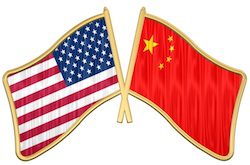 The United States is losing its competitive edge against an emerging economic superpower. China is on track to surpass U.S. gross domestic product in 2020 and it is increasingly competing with world renowned American innovation.
The United States is losing its competitive edge against an emerging economic superpower. China is on track to surpass U.S. gross domestic product in 2020 and it is increasingly competing with world renowned American innovation.
China has historically been a global leader in innovation. They are the first nation to invent a wealth of crucial technologies including the magnetic compass, gunpowder, cast iron, the chain suspension bridge, paper, printing and the wheelbarrow. The Chinese also invented technologies involving mechanics, hydraulics, and mathematics. But that was many centuries ago, and these technologies were used by the West to establish their technological dominance. Now China is using western technology to grow its economy, but they are also re-emerging as a leading center of innovation.
China is advancing its innovative capabilities by employing a uniquely Chinese approach and by looking to advanced countries for inspiration. The Chinese are now dominating the world in wind turbines, solar panels and high-speed rail.
The Chinese Academy of Sciences’ (CAS) goals for 2020 include environmental innovation. China is planning to invest $1.5 trillion in strategic areas. This includes alternative fuel cars, alternative energy, high speed rail, energy efficiency and other environmentally friendly technologies.
In the annual report to the National People’s Congress in March 2010, Premier Wen Jiabao called for “pushing forward with building a smart grid”. Over the next five years, State Grid Corp of China, plans to build an “informationised, automatic and interactive” grid with ultra high voltage power lines.
When it comes to energy, China has demonstrated a commitment to hydro, wind, gas and nuclear. China has already surpassed many of the targets it set in 2007. The government is expected to unveil new more ambitious targets for alternative energy in the next few months.
China plans to build 13,000 km (8,078 miles) of high-speed rail lines by 2012, more than the rest of the world combined. The country plans to invest 2 trillion yuan in railways by 2020, while building a fleet of state-of-the-art trains.
China also controls 97 percent of the world’s rare earth minerals including lithium, a metal that is crucial to the development of the batteries used in electric cars.
Chinese innovation is not limited to cleantech. China is now the number two patent filer in the world. The Chinese are poised to be global leaders in space and DNA-sequencing. China is also working on the world’s largest single-dish radio telescope. China is emerging as a world leader in everything from paleontology to nanotechnology and in 2011, China will consolidate its position as the second-largest national source of scientific papers.
As outlined in his 2011 State of the Union address, President Obama wants to put more emphasis on innovation and education. Obama is not alone, national leaders like Russian President Dmitry Medvedev and Prime Minster Naoto Kan of Japan indicate that innovation is the key to economic competitiveness
Adam Segal of the Council on Foreign Relations in New York and author of the new book: Advantage: How American Innovation Can Overcome the Asian Challenge, argues that China is rapidly gaining the advantage in hardware innovation, which includes things like papers and patents. But according to Segal, China cannot compete in what he calls software innovation. Software includes the political, social and cultural understandings that help move ideas from labs to the market place.
However, China is also striving to innovate at the political, social and cultural levels. On February 19, 2011, at an event that was attended by the leaders of China’s government, military, state-owned enterprises, financial institutions and institutions of higher learning, Chinese President Hu Jintao called for innovations to improve social management.
America is still the undisputed global leader in innovation and Segal argues that America is well positioned to take advantage of global innovation.
“I think innovation is clearly at the top of that list and I also think that it is important that people realize this is an area of strength for us. If you look at how innovation is changing, it is becoming more globalized, spread around the world to all of these newly emerging science and technology centers in China and India. And the U.S., in fact, is well positioned to take advantage of those. We have extensive connections to all of those places through alumni networks, university collaboration and corporate networks. I think the U.S. is better positioned than any country to take advantage of this kind of new global system of science and technology. So I think it’s important for the president to point to our strengths and some of the things we need to do as we move forward.”
However, without federal government support, America is destined to fall behind. China is one of the world’s largest investors in research and development, their spending on R&D has climbed by 19% per year since 1995 to reach US$30 billion in 2005.
For the United States to maintain its edge in innovation, Segal believes the US will need to keep investing in institutions like the National Science Foundation and the Department of Energy. But these investments will need to survive Republicans who seem intent on cutting into the fabric of American innovation. Innovation will continue to grow in China and if the US is to compete, it will need to ward off Republican cuts.
——————–
Richard Matthews is a consultant, eco-entrepreneur, sustainable investor and writer. He is the owner of THE GREEN MARKET, one of the Web’s most comprehensive resources on the business of the environment. He is also the author of numerous articles on sustainable positioning, green investing, enviro-politics and eco-economics.


